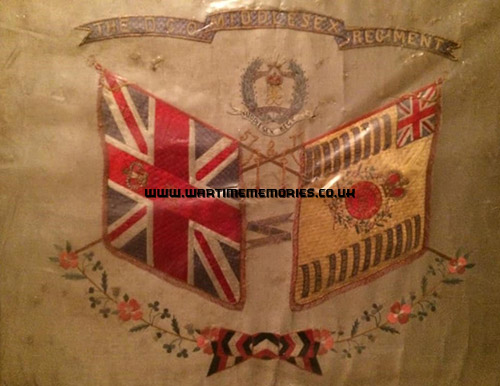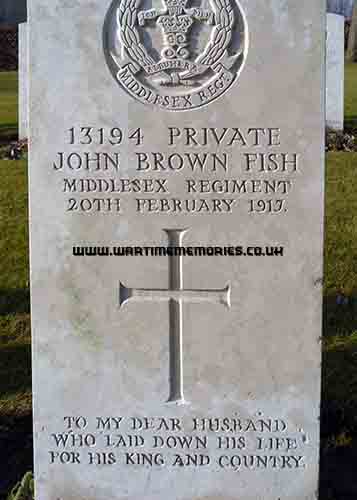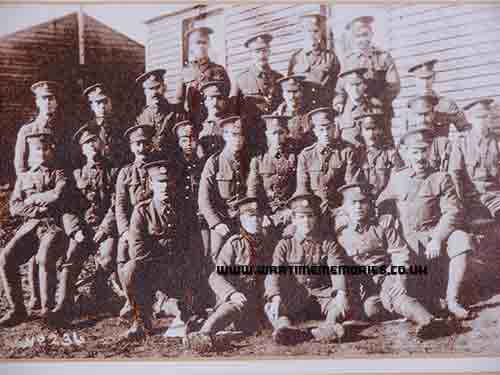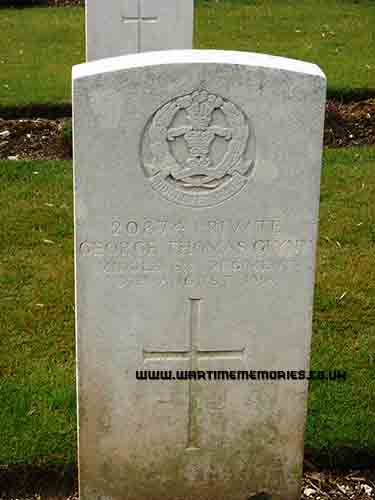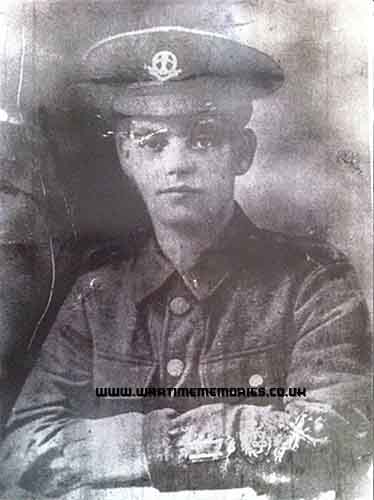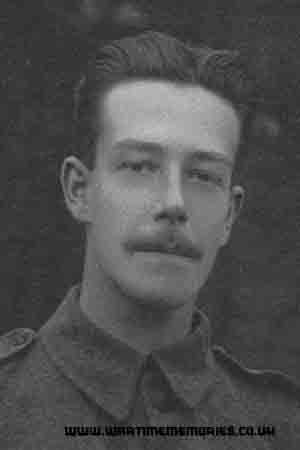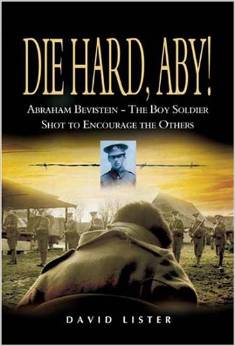|
|
|
11th Battalion, Middlesex Regiment
11th Battalion, Middlesex Regiment (Duke of Cambridge's Own) was raised at Mill Hill in August 1914 as part of Kitchener's First New Army and joined 36th Brigade, 12th (Eastern) Division. They trained at Colchester moving to Shorncliffe in November and in February 1915 they moved into Ramillies Barracks at Aldershot for final training. The Division proceeded to France between the 29th of May and 1st of June 1915 landing at Boulogne, they concentrated near St Omer and by 6th of June were in the Meteren-Steenwerck area with Divisional HQ being established at Nieppe. They underwent instruction from the more experienced 48th (South Midland) Division and took over a section of the front line at Ploegsteert Wood on the 23rd of June 1915. They were in action in The Battle of Loos from the 30th of September, taking over the sector from Gun Trench to Hulluch Quarries consolidating the position, under heavy artillery fire. On the 8th they repelled a heavy German infantry attack and on the 13th took part in the Action of the Hohenzollern Redoubt, capturing Gun Trench and the south western face of the Hulluch Quarries. During this period at Loos, 117 officers and 3237 men of the Division were killed or wounded.By the 21st they moved to Fouquieres-les-Bethune for a short rest then returned to the front line at the Hohenzollern Redoubt until the 15th of November, when they went into reserve at Lillers. On the 9th of December, 9th Royal Fusiliers assisted in a round-up of spies and other suspicious characters in the streets of Bethune. On the 10th the Division took over the front line north of La Bassee canal at Givenchy. On the 19th of January they began a period of training in Open Warfare at Busnes, then moved back into the front line at Loos on the 12th of February 1916. In June they moved to Flesselles and carried out a training exercise. They moved to Baizieux on the 30th June and went into the reserve at Hencourt and Millencourt by mid morning on the 1st of July. They relieved the 8th Division at Ovillers-la-Boisselle that night and attacked at 3.15 the following morning with mixed success. On the 7th they attacked again and despite suffering heavy casualties in the area of Mash Valley, they succeeded in capturing and holding the first and second lines close to Ovillers. They were withdrawn to Contay on the 9th July. They were in action in The Battle of Pozieres on the 3rd of August with a successful attack capturing 4th Avenue Trench and were engaged in heavy fighting until they were withdrawn on the 9th. They moved north and in 1917 were in action at Arras in The First Battle of the Scarpe, The Battle of Arleux and The Third Battle of the Scarpe. They remained in the Arras sector until the 30th of October when they moved to Hesdin for the Cambrai offensive in which the Division suffered heavy losses. The 11th Middlesex were disbanded in France on the 7th of February 1918 when the army was reorganised.
10th Jun 1915 On the March
25th Jun 1915 On the March
11th Sep 1915 Last day of Derby Scheme Recruitment
11th Sep 1915 Artillery Active
26th Sep 1915 Reliefs Completed
27th September 1915 Orders
1st Oct 1915 Consolidation
15th Oct 1915 Artillery In Action
16th Oct 1915 The Derby Scheme
20th Oct 1915 Enemy Attack
21st Oct 1915 Reliefs
25th Oct 1915 On the March 
31st Oct 1915 Training
2nd Nov 1915 In the Trenches
5th Nov 1915 Reliefs
18th Nov 1915 On the March 
1st Dec 1915 Derby Scheme Armlets
10th Jan 1916 Group System Reopens
16th Jan 1916 On the Move
19th Jan 1916 Drill
20th Jan 1916 Inspection
25th Jan 1916 Route March
30th Jan 1916 On the March
1st Feb 1916 Orders Cancelled
3rd Feb 1916 Reorganisation
5th Feb 1916 Change of Billets
9th February 1916 Call Ups
13th Feb 1916 Exchange of Fire
24th Mar 1916 Enemy Mine Fired
30th Mar 1916 Change of Billets 
2nd Apr 1916 Church Parade
17th Apr 1916 On the Move 
3rd May 1916 Route March
14th May 1916 Heavy Rain
15th May 1916 Still Raining
18th May 1916 Training
20th May 1916 Brigade Sports
27th Jun 1916 On the March
1st July 1916 In Reserve
31st Jul 1916 Attack Made
3rd July 1916 In the Trenches
7th July 1916 Attack Made 
8th July 1916 Reliefs Completed
10th Jul 1916 On the March
11th Jul 1916 On the March
27th Jul 1916 On the March
28th Jul 1916 11th Middlesex in action at Poziers On this day, during the battle for Poziers, the 11th Middlesex were part of Maj-Gen Scott's 12th Division which relieved the 48th division. The 48th had been in the line for twelve days and its casualties amounted to almost 2,800 all ranks. The 11th Middlesex moved over open ground to secure the extension of Western Trench in order to keep in touch with the 23rd Victoria Battalion. The attack was repelled by grenades and rifle fire.
29th Jul 1916 Working Party
30th Jul 1916 Attack Made 
10th Aug 1916 Royal Inspection
11th Aug 1916 On the March
16th Aug 1916 On the March
17th Aug 1916 On the March
1st Oct 1916 Reliefs
2nd Oct 1916 Heavy Shelling
3rd Oct 1916 Shelling
4th Oct 1916 Shelling
5th Oct 1916 Heavy Shelling
6th Oct 1916 Shelling
7th Oct 1916 Attack Made
8th Oct 1916 Heavy Shelling
12th Oct 1916 Attack Made
26th Feb 1917 Trench Raid
27th Feb 1917 Relief Complete
6th Mar 1917 Inspection
12th May 1917 Attack Made
1st Jan 1918 Training
2nd Jan 1918 Training
3rd Jan 1918 Training
4th Jan 1918 Training
5th Jan 1918 Moves 
6th Jan 1918 Moves 
7th Jan 1918 Training
If you can provide any additional information, please add it here.
|
| Want to know more about 11th Battalion, Middlesex Regiment? There are:76 items tagged 11th Battalion, Middlesex Regiment available in our Library There are:76 items tagged 11th Battalion, Middlesex Regiment available in our Library 
These include information on officers, regimental histories, letters, diary entries, personal accounts and information about actions during the Great War.
|
|
Those known to have served with11th Battalion, Middlesex Regiment during the Great War 1914-1918. - Barlow George Edward. Pte. (d.4th Nov 1915)
- Beverstein Abraham. Pte. (d.20th March 1916)
- Beynon William Hayden. L/Cpl. (d.5th Oct 1918)
- Carter Henry. Pte. (d.26th Apr 1916)
- Eades Cyril Edgar. Sgt.
- Fish John Brown. Pte. (d.20th Feb 1917)
- Fitzjohn Bertram George. Pte.
- Gill James Henry. Pte. (d.8th Jul 1916 )
- Glynn George Thomas. Pte. (d.8th Au 1916)
- Lane William James. Pte.
- Mitchell Albert. Pte. (d.19th Apr 1918)
- Nobbs Harry Alexander. Pte. (d.9th Apr 1917)
- Norton John Henry. Pte. (d.15th Nov 1916)
- Pezaro Jack. A/Cpl. (d.8th Oct 1916)
- Saxon Pip Alfred Edwin. Sgt.
- Shingleton Albert. Sgt.
- Skinner John. Pte. (d.15th Feb 1916)
- Tedder William Charles. L/Cpl. (d.23rd Apr 1917)
- Walters James Robert. Pte.
- West Albert William. Pte. (d.26th Feb 1917)
- Winter Christopher James. Pte. (d.12th April 1917)
All names on this list have been submitted by relatives, friends, neighbours and others who wish to remember them, if you have any names to add or any recollections or photos of those listed,
please Add a Name to this List
Records of 11th Battalion, Middlesex Regiment from other sources.
|
|
The Wartime Memories Project is the original WW1 and WW2 commemoration website.

- 1st of September 2024 marks 25 years since the launch of the Wartime Memories Project. Thanks to everyone who has supported us over this time.
|
Want to find out more about your relative's service? Want to know what life was like during the Great War? Our
Library contains many many diary entries, personal letters and other documents, most transcribed into plain text.
|
Looking for help with Family History Research?
Please see Family History FAQ's
Please note: We are unable to provide individual research.
|
|
Can you help?
The free to access section of The Wartime Memories Project website is run by volunteers and funded by donations from our visitors.
If the information here has been helpful or you have enjoyed reaching the stories please conside making a donation, no matter how small, would be much appreciated, annually we need to raise enough funds to pay for our web hosting or this site will vanish from the web.
If you enjoy this site
please consider making a donation.
Announcements
- 26th Mar 2025
Please note we currently have a massive backlog of submitted material, our volunteers are working through this as quickly as possible and all names, stories and photos will be added to the site. If you have already submitted a story to the site and your UID reference number is higher than
265607 your submission is still in the queue, please do not resubmit.
Wanted: Digital copies of Group photographs, Scrapbooks, Autograph books, photo albums, newspaper clippings, letters, postcards and ephemera relating to the Great War. If you have any unwanted
photographs, documents or items from the First or Second World War, please do not destroy them. The Wartime Memories Project will give them a good home and ensure that they are used for educational purposes. Please get in touch for the postal address, do not sent them to our PO Box as packages are not accepted.
|
World War 1 One ww1 wwII greatwar great battalion regiment artillery
Did you know? We also have a section on World War Two. and a
Timecapsule to preserve stories from other conflicts for future generations.
|
|
|
Sgt. Alfred Edwin Saxon Pip 1st Btn. Middlesex Regiment I never knew my great grandfather Alfred Saxon, but I do know that he never spoke about his time at war. He served with the 1st, 2nd and 11th Battalions Middlesex Regiment. It sounds like he might have suffered from PTSD as he would just disappear leaving my great nan with 10 children to fend for.
Alfred was very proud of his silk Regimental flag which he hung over his fire place. My mum now has that, and one day it will pass to me.
I've learnt that when he first enlisted at age 18, he was quite naughty, and always having his pay docked, and on two occasions he was imprisoned for 168 hours with hard labour.
He also had several tattoos, 2 of which are referred to on his army records as 'scars above both buttocks'. These scars were actually 2 clown tattoos.
My great grandfather served a total of 17 years in the Middlesex Regiment and was promoted to sergeant in Feb 1915.
|
Pte. Albert Mitchell 1st Btn. Middlesex Regiment (d.19th Apr 1918) My Gt.Uncle Albert Mitchell was a golf professional before WW1. He came from a family of professional golfers and was first cousin to Abe Mitchell whose effigy adorns the Ryder Cup. He honed his craft on the Royal Ashdown Forest Golf Club, Forest Row, Sussex.
Albert was the youngest son of Arthur and Susan Mitchell.
Initially he joined the West Kent Yeomanry but transferred to the Middlesex Regiment.
In 1916 he was wounded at the Somme. After a period of convalescence at home, he returned to France.
He died in action on 19th Apr 1918.
His body is buried at the Meteren Cemetery, France.
Albert did not marry and was 32 when he died.
|
Sgt. Albert Shingleton 11th Battalion Middlesex Regiment Prior to the Great War, Albert Shingleton was employed in London as a baker. According to Serjeant Albert Shingleton's WW1 Pension Record, he enlisted into the 11th Battalion, Middlesex Regiment on 7th of August 1914, with service number G/215.
While overseas, the 11th Battalion served with 12th (Eastern) Division, which was engaged in heavy combat in the Battles at Loos, the Somme and Arras. As indicated on his Medal Roll Index Card, Serjeant Shingleton entered the French theatre on 31st of May 1915, thereby qualifying for the 1914-15 Star.
Per his Pension Record, he was evacuated to England on 23rd of October 1917 due to bronchitis, this diagnosis was later changed to tuberculosis. On 12th of December 1917, he was discharged from the British Army as "no longer physically for for War Service".
In addition to the 1914-15 Star, he was awarded the British War Medal and Victory Medal.
According to British and Canadian Passenger Lists, it is highly likely that Albert Shingleton (by himself) moved to Canada in late 1919 and remained there until he transited back to Britain with his wife Alice in early 1934. Later, in late 1947, he and Alice returned to Canada.
|
Pte. John Brown Fish 11th Battalion Middlesex Regiment (d.20th Feb 1917) John Fish, sadly killed in action on the 20th February 1917.
|
Pte. George Thomas Glynn 11th Btn. Middlesex Regiment (d.8th Au 1916) George Glynn was born on 19th June 1882 in Islington. He married Sophia Hannah Martin on 2nd August 1903 at Chingford Hatch and had nine children, of which seven were still alive when he joined the 11th Battalion Middlesex Regiment. It is believed he was wounded during the battle for Pozieres Wood and subsequently died of his injuries on 8th August 1916. He is buried at Abbeville Cemetery, France.
|
Pte. Harry Alexander Nobbs 11th Btn. Middlesex Regiment (d.9th Apr 1917) Harry Nobbs was my grandfather, born in 1877, he died at Arras on the 9th April 1917, leaving a widow and 5 children. Harry has no grave, he is commemorated on the wall at Arras and at St Mary's church, Hampton Middlesex. I have never seen a picture of Harry and would love to see what he looked like.
|
A/Cpl. Jack Pezaro 11th Btn. Middlesex Regiment (d.8th Oct 1916) Jack Pezaro signed up with his brother Harry in about 1914, when he was 19. He served as Acting Corporal. He fought at the Somme and was killed in action there alongside his brother. They are remembered on the Thiepval Monument.
|
Pte. George Edward Barlow 11th Battalion Middlesex Regiment (d.4th Nov 1915) George Barlow was my great uncle. He was my grandfather's, Joseph Frederick Barlow's, elder brother.
George served with 11th Bn Middlesex Regiment and was the son of Thomas Cornish Barlow and Kate Barlow of 11 Tower Street, Wolverhampton. He died on the 4th November 1915. Aged 24. He is remembered on the Loos Memorial.
|
Pte. Bertram George Fitzjohn 11th Btn. Middlesex Regiment Bertram George Fitzjohn was my step father, he served with 11th Btn. Middlesex Regiment.
|
Pte. William James Lane 2nd Btn. Middlesex Regiment Private 8167 William James Lane also served in the 7th and 11th Battalion of the Middlesex Regiment. His medal card shows that he embarked for France on 8th June 1915 meaning that he was probably, at that time, serving with the 11th Battalion as that is when they were moved to France.
|
Pte. James Henry Gill 11th Btn. Middlesex Regiment (d.8th Jul 1916 ) James Henry Gill, died in action in France on 8th July 1916, aged 29. He is commemorated on the Thiepval Memorial to the Missing of the Somme.
He was the son of Henry Gill and had married Kathleen Gray on 7th June 1909 Kingston Surrey Middlesex England.
Their daughter,Lillian Kathleen Gill, was born 8th September 1910, followed by a son, James Henry Gill Jnr., on 24th May 1913.
Kathleen and the children immigrated to Perth, Western Australia in 1919. Life was a struggle and the children were place in care in 1925.
James Henry Gill Jnr. is buried in Pinjarra, Western Australia.
Still trying to find the stories behind James Snr.,Kathleen and Lillian.
|
Pte. John Henry Norton 11th Battalion Middlesex Regiment (d.15th Nov 1916) John Norton was my late grandfather Frank's older brother).
He was killed on the battlefield east of Arras and is buried in Agny Cemetery, Pas De Calais.
I have his service medals and the 'Death Penny' and letter sent to his mother (Martha).
My grandad never talked about what happened to his older brother, he was only 9 when John was killed.
|
L/Cpl. William Charles Tedder 11th Battalion Duke of Cambridge's Own (Middlesex Regiment) (d.23rd Apr 1917) My Great Uncle, William Charles Tedder died of wounds in the Military Hospital, Etaples, France. He is buried in the Etaples Military Cemetery, France. William Tedder was Formerly 5063, Lancers. I have a photo of his grave.
|
Sgt. Cyril Edgar Eades 11th Btn. Middlesex Regiment Cyril Eades served with the 11th Battalion, Middlesex Regiment during WW1.
|
Pte. Henry Carter 11th Btn. Middlesex Regiment (d.26th Apr 1916) Henry Carter served with the Middlesex Regiment 11th Battalion. He was executed for desertion 26th April 1916 aged 18 and is buried in Sailly-Labourse Communal Cemetery in Sailly-Labourse, France.
|
Pte. Abraham Beverstein 11th Btn. Middlesex Regiment (d.20th March 1916)  Abraham was executed for desertion 20/03/1916 and buried in Labourse Military Cemetery, Pas-de-Calais, France.
In September 1914 Abraham Beverstein, of Whitechapel in the east of London, joined the army under the name Abraham Harris. He did not tell his parents he had enlisted until afterwards: he was afraid they would have stopped him. He was 18 years old, and their only son. From the training camp at Aldershot, the boy wrote home: ˜I was very sorry to leave you, and very sorry to see you cry, but never mind, I will come back one day, so be happy at home. From your loving son Aby.
In the spring of 1915 his battalion went to fight in France. (˜Dear mother, I do not like the trenches...) At the end of the year Abraham was in the army hospital; an official telegram to his parents reported that he was ˜suffering from wounds and shock (mine explosion). In January 1916, however, he was able to write reassuringly, ˜I am feeling a little better, so dont get upset. Three weeks later he was sent back to his unit.
But soon afterwards another letter reached Whitechapel: ˜Dear mother, we were in the trenches and I was ill, so I went out and they took me to the prison, and I am in a bit of trouble now....I will have to go in front of a Court. This was the last his parents heard from Abraham.
In April they received the following letter, in every way insensitively expressed. It came from the senior officer in charge of Infantry records. ˜Sir, I am directed to inform you that a report has been received from the War Office to the effect that [Abrahams army number and regiment - not his name] was sentenced after trial by court martial to suffer death by being shot for desertion, and the sentence was duly executed on 20th March 1916. I am, Sir, your obedient servant....
In his statement to the court martial (he had no legal representation) Abraham explained, ˜I left the trenches because three rifle grenades exploded near me. I was deafened and my nerves had gone a bit. He saw a medical officer, who told the court he had ˜found him suffering from no appreciable disease... I told him he was fit for duty. Another soldier had come across Abraham by chance at the farm where the boy was billeted - the nearest thing to home. ˜Harris told me he had just come out of hospital, the soldier said. ˜He had no greatcoat or hat and was covered in mud. He stayed in the farm all afternoon sitting by the fire warming himself. In the evening Abraham was arrested.
His landlady at the farm told the court, He said the trenches were being bombed and he had left them and was going to England. Abraham himself said, ˜I felt nervous and lost my head. I thought Id stay at the farm for a few days and go back to the company when they came out of the trenches. Those were the words that condemned him: the court was convinced that he had intended to desert.
Sylvia Pankhurst, a tireless campaigner for human rights and social reform, knew Mr and Mrs Beverstein and took up their sons case. She published his letters in her magazine ˜Dreadnought and protested vehemently against the injustice of executing a 19-year-old volunteer who had endured 8 months in the trenches and had only just come out of hospital with injuries and shell-shock. As a result there was a question about Abraham in the House of Commons, but the only real outcome was that hence forward executed soldiers were simply said to have ˜died of wounds.
|
Pte. John Skinner 11th Battalion Middlesex Regiment (d.15th Feb 1916) Jack Skinner served with the Middlesex Regiment. Originally from Chittlehamholt in North Devon , he died in February 1916.
|
Pte. Albert William West 11th Btn. Middlesex Regiment (d.26th Feb 1917) Bill West is buried in Faubourg d'Amiens, he was aged 21 years and 9 days old.
|
Recomended Reading.Available at discounted prices.
|
Die Hard, Aby!: Abraham Bevistein - The Boy Soldier Shot to Encourage the Others David Lister
'Die Hard, Aby!' tells Aby's story, rather than that of the historic times through which he lived. If a well known battle rages while Aby sits in a trench several miles away, writing to his mum - we are with Aby. We follow him from the Russian occupied land of his birth, across Europe to his East End home, and then through school days and the events that led to the Great War. One of the first to join, we see him through training and on to duty at the Front. We are with him in the mud of the trenches and share his deprivations through the cold of the winter of 1915. After 10 months in France, we see what led him to leave the Front without authority. We are with Aby again when as a 17-year-old boy he walks to his fate on a cold, March dawn in 1916. Finally we examine the impact his short life had on his times and on ours.
|
|
|





